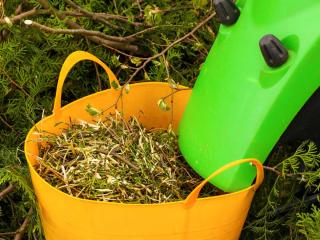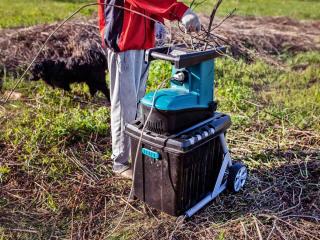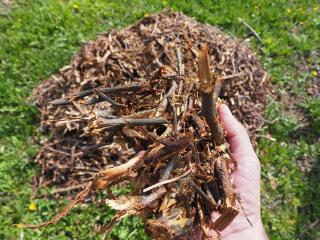

Shredding plant waste is possible THE ultimate way to compress all that volume. Way less endless trips to the dump! You might even cut that back to zero – chipped waste proves quite handy in the garden, whether fresh or composted! Here are our non-biased tips on choosing the right garden shredder.
→ Read also: choosing the right chipper
Getting the power of your shredder right is crucial. Prices swing wildly based on the motor type (electric or gas), grinding speed, and output size: it’s worth your while to carefully work out what you really need.
Finer ouput material is better for composting and reducing volume. But if you’re mulching, go for a coarser, rougher grind. Pieces a few inches long, for instance (5-10 cm).
Electric motor powers range from 2 to 3.5 horsepower (1500W to 2500W). To chip up branches smaller than 1.5 inches across (40 mm), go for at least 2.5 horsepower (1800W). You’ll need a 16 Amps (16A) outlet, so make sure you can access that from the garden side. Maximum branch size for most home devices range from 1.2 to 2 inches (30 to 50 mm).
Cutter/grinder systems come in either of 3 technologies: blade grinder, screw grinder, and rotor grinder. The latter two pack a punch, are quieter in operation, and also crush waste after shredding it.
 A blade shredder sports sharp blades attached to a horizontal disc. It can shred wood of 1.2 to 1.4 inches (30 to 35 mm), thanks to a high rotational speed. Some designs come with wide planer-type blades for an even finer grind. These tend to be somewhat noisier and sometimes shoot chips back upward: you must hold branches firmly. They easily handle soft material like perennial stems and vegetable peelings in addition to the small branches they’re marketed for. A check valve is recommended for clearing clumps. Of all grinder types, output is the finest. Maintaining sharp blades is crucial. They can also be replaced.
A blade shredder sports sharp blades attached to a horizontal disc. It can shred wood of 1.2 to 1.4 inches (30 to 35 mm), thanks to a high rotational speed. Some designs come with wide planer-type blades for an even finer grind. These tend to be somewhat noisier and sometimes shoot chips back upward: you must hold branches firmly. They easily handle soft material like perennial stems and vegetable peelings in addition to the small branches they’re marketed for. A check valve is recommended for clearing clumps. Of all grinder types, output is the finest. Maintaining sharp blades is crucial. They can also be replaced. Noise pollution from a shredder can range from 68 to 106 decibels. Ear protection might come in handy (and knowing when local ordinances allow you to operate it will smooth relationships with neighbors).
Noise pollution from a shredder can range from 68 to 106 decibels. Ear protection might come in handy (and knowing when local ordinances allow you to operate it will smooth relationships with neighbors).The shredded material, of course, can go straight into composting, making for fantastic soil mix.

→ Note that the quantity of chipped branches should not exceed more than 20% coniferous in this mix. Steer clear of thuja and eucalyptus as they kill off useful fungi involved in wood decomposition.
Apart from reducing weeding and watering chores and preventing soil erosion, this new form of mulch brings along many benefits:
Spread it as soon as possible after shredding to prevent it from starting to ferment.
Indeed, fermentation heat can kill microfauna and microflora contained in the product. To slow down its fermentation, form not too thick and well-aerated piles.
Spread RCW. preferably in fall or early winter, at the base of trees, in shrub beds and even in the vegetable garden. Bury it to 0.8-1.2 inches (to 2-3 cm), with a broadfork or rototiller, or simply form a mulch layer 1.2 to 2 inches thick (3 to 5 cm thick).
One thing to be aware of if you’re a first-time user: RCW decomposition initially causes a temporary 2-3-month “nitrogen sink” where the nutrient is less available. This could impede growth of young plants in spring.